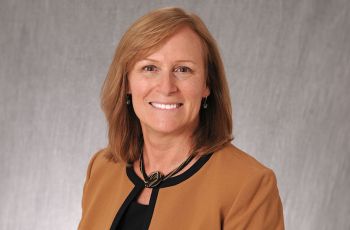The concept of “flow” is a defining characteristic for Ramesh Mazhari. As an interventional cardiologist, she is dedicated to restoring and improving patient blood flow to the heart. As a researcher, she has transitioned almost effortlessly from one new idea to the next. And, with guidance from mentors along the way, Mazhari hopes to make it possible for basic science discoveries to move swiftly from concept to patient care. In the clinic that treats vessel blockages, Mazhari, M.D., G.M.E. ’02, G.M.E. ’05, assistant professor of Medicine in the Division of Cardiology at GW’s School of Medicine and Health Sciences (SMHS), has earned a reputation as an expert in the use of transradial catheterization on patients who experience a blockage of blood flow to their hearts. In the laboratory, pursuing stem cell research to restore heart muscle function, she is exploring the molecular level of information flow. She is trying to determine the pathways that prompt the body to cue — or crush — the cell growth needed to repair a damaged heart. She hopes one day to harness that signaling system to devise regenerative cardiac treatments. And as a master’s degree student in SMHS’s first class of translational medicine specialists, Mazhari is moving to the next big paradigm in medicine.
Insight and Action
Mazhari, who completed her residency in internal medicine at GW in 2002 as well as a fellowship in cardiac intervention at GW in 2005, returned to SMHS three years later as a member of the Cardiac Catheterization Laboratory at GW Hospital. With encouragement from her mentor, and now colleague, Jonathan Reiner, M.D., professor of Medicine and director of GW’s catheterization lab, Mazhari pursued training in transradial access. The specialized cardiac catheterization procedure offers safer access to the heart through the radial artery in the patient’s wrist rather than taking the traditional approach through the femoral artery.
The procedure was developed about 20 years ago in Europe. Although only about 5 percent of cases in the United States use transradial access, it is now the preferred method in more than 50 percent of cases in Europe, Canada, and Japan. The U.S. standard relies on the larger, straighter femoral artery in the groin as a route to the heart. Both approaches enable physicians to diagnose coronary blockages, and, where possible, restore blood flow by threading a stent through the catheter to prop open the vessel. The femoral procedure, however, presents bleeding risks and significantly greater discomfort for the patient due to the artery’s location deep within the thigh muscle. Transradial access is ostensibly more difficult because the radial artery is smaller than the femoral artery, and the route to the heart is less direct (the physician has to guide the catheter up through the patient’s arm around the shoulder to reach the heart). Nonetheless, the procedure is safer because it reduces the risk of bleeding, and it provides a faster recovery time; patients sometimes go home on the same day as the procedure.
As is typical of Mazhari’s style, action followed the insights she gained from her catheterization training. “After three or four cases, I was convinced that transradial access was the better procedure for a cardiac intervention because it’s better for the patient,” she says.
Mazhari suggested to Reiner that GW expand its use of transradial access, and after some careful evaluation he adopted his protégé’s enthusiasm for the technique. The results were so positive that radial access soon became the lab’s preferred approach.
“It’s a much more patient-centered approach,” says Reiner. “While the procedure often takes several months for physicians to really learn, once they have the expertise, they can perform it just as quickly, more safely, and less expensively compared with the more common procedure of going through the femoral artery.”
Most catheterization labs in the United States opt for the femoral procedure as a first option and switch to the radial artery only if there is potential for complications with the traditional approach, according to Reiner. GW turned that scenario on its head. “Today at GW Hospital, we perform almost 90 percent of catheterizations through the wrist,” he says. “The procedural outcomes are equivalent, and patients prefer it.”
Reiner beams with added satisfaction that the switch to transradial access was born of homegrown talent. “Ramesh is someone I trained,” recalls Reiner, “but she has changed my practice and influenced a generation of our fellows at GW.”
As a result of the transition, GW has become a wellspring for training in the transradial technique. “Our fellows come out of their years with us having performed hundreds of cases, and they really become experts at it,” says Reiner. Through its fellowship programs, GW provides specialized training in transradial access for two interventionalists and eight general cardiology fellows annually. In addition, three or four established physicians travel to GW each month to learn the technique.
Connect. Flow. Transform. It’s an algorithm for speeding the current of innovation to patients. Mazhari attributes her inspiration in exploring new channels of care to the many influential mentors who have guided her along her relatively young career as a physician.
“A great mentor is not just a doctor who teaches you how to perform a procedure the way he or she does, or how to understand a condition based only on their own experience,” Mazhari explains. “A great mentor teaches you to be imaginative, to think differently, and to continue to learn as much as you can.”
Of Pig Labs and Practice Change
Mazhari’s drive for “different and better” was instilled early in her medical career during a fellowship at Boston’s Brigham and Women’s Hospital. Developing a research project taught her the fine-grained details of how to build an operational foundation for research, including managing stakeholder input, policy implications, grant requirements, and reporting mandates. Right away Mazhari knew she wanted a career in both research and patient care. At the time, however, translational medicine — quickly moving advances in research from the bench to better clinical care at the bedside — was only beginning to take shape at a few academic medical centers.
Again, mentoring made the difference for Mazhari. Working on another fellowship under Joshua Hare, M.D., who was a pioneer in the use of stem cells for repairing damaged heart muscle and was then at Johns Hopkins University, Mazhari realized that her dual expertise in research and patient care was clinically relevant. During the year-long fellowship, she found herself in the lab as a basic science researcher investigating stem cells and their impact on the heart physiology of pigs. Pigs are routinely used in cardiac research because their heart anatomy is similar in size, structure, and function to that of humans. Mazhari’s task during the project served as a counterpoint to her current role as an interventional cardiologist. “Instead of clearing vessels to restore blood flow, I was trying to close vessels to induce a heart attack in the pigs,” she explains. “Then we would inject cardiac stem cells to see if there was any therapeutic effect on the heart. In doing a little bit of everything — basic science research and clinical care — I really found my calling.”
Creative Collaborations
Mazhari kept seeking a link between science and patient care. Upon her return to GW in 2008, she found a fertile environment in which to integrate her understanding of clinical care and her interest in hard science. The combination of freedom and direction offered by mentors such as Reiner, Timothy McCaffrey, Ph.D., professor of Biochemistry and Molecular Biology, and Eric Hoffman, Ph.D., professor of Pediatrics at GW’s SMHS and Children’s National Medical Center, enabled Mazhari to reach beyond convention.
This spring she joined one of the nation’s few translational medicine degree programs — and the only one in the Washington, D.C., area. Mazhari is among GW’s inaugural class of 15 M.D.s and Ph.D.s training to bridge gaps in care and build new platforms for improved health by quickly translating advances in basic science into new clinical treatments for patients. The degree program is part of a partnership between GW and Children’s National Medical Center thanks to a National Institutes of Health grant — the prestigious Clinical and Translational Science Award.
Joseph Bocchino, Ed.D., M.B.A., assistant professor and chair of SMHS’s Department of Clinical Research and Leadership, directs GW’s new degree program. He believes translational medicine exerts new demands on leaders to evolve beyond the rapidly declining model of care marked by the heroic surgeon, the lone genius in the lab, the solo clinician.
“This emerging domain is all about a social-networking approach to problem solving,” Bocchino explains. “It’s done largely through multidisciplinary teams, not isolated or loosely affiliated individuals. So the process requires a new leadership style. Defining and developing this new leadership style is one of the essential educational pieces of our program.”
He adds that traditional research programs train people in a deep, but narrow, scope of interest. “In this new program, the strategy is to help people develop a broader base of experience across the continuum, from basic science, to clinical research, to matters of health policy.”
Mazhari explains, “I was attracted to the opportunity to enter GW’s translational medicine degree because I had firsthand experience both in basic heart research and in applying new knowledge to patient care.”
Making the Connection to Better Care
Translational medicine is changing how scientific research is conducted and health care is delivered in the U.S. because it’s helping to overcome medicine’s past problems: A system fragmented between basic laboratory research, clinical care of patients, and policy support for best-practice methods and therapies.
“In health care right now, there is a huge gap between what we know and what we deliver,” says Mazhari. “My job as a clinician going through this program is to connect those two worlds through translational research. My goal is to take the rapidly growing basic science research, and use those techniques to try to answer very relevant clinical questions. It’s exciting to have this opportunity because in medicine, there’s so much more we can do for patients when we can make this connection.”
Connect. Flow. Transform.


